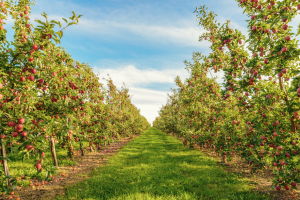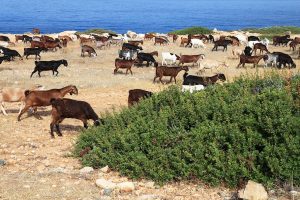Disadvantages of Mono-Crops and GMOs
Mono-cropping agriculture is the lifeline of animal farming factories. You can’t have massive amounts of cows without feeding them massive amounts of grain. Likewise, you can’t grow massive amounts of grain without massive amounts of land, pesticides, and tons of fresh water.
Mono-cropping is the agricultural practice of growing a single crop, year after year, on the same land. This explicitly entails the absence of crop rotation. Corn, soybeans, and wheat, are three common crops widely grown using mono-cropping techniques.
There are dozens of issues with mono-cropping, but we don’t have space to explore them all in this book. Nevertheless, it is important to name a few, to understand the effects of our actions when we buy things like animal flesh and genetically modified grains.
Economically speaking, and only in the short run, mono-cropping can be an efficient system, allowing for specialization in equipment and crop production. This efficiency allows for massive grain production but it comes at a huge cost. Mono-crops damage the soil ecology, including depletion, or reduction, in diversity of soil nutrients. This results in a more fragile ecosystem, with an increased dependency on pesticides and artificial fertilizers.
Moreover, mono-cropping emphasizes the use of specialized farm equipment, an essential component to keep the system efficient. This leads to an increased dependency on fossil fuels, and reliance on expensive machinery that isn’t manufactured locally. This has led to huge economics changes in regions accustomed to self-sufficiency through agricultural production.
Mono-crops take massive amounts of land and dedicate them to growing a single crop. Corn, for example, is produced in huge fields, using huge machinery and massive amounts of pesticides. To acquire these huge pieces of land, large companies buy them from small farmers, or engage in deforestation practices, cutting down countless trees to replace them with corn fields. After a few years, these fields dry up. Where there used to be forests now we have desserts.
Additional disadvantages of mono-cropping include the use of genetically modified seeds, which have not been properly tested for human consumption over long periods of time. Plenty of research performed over the past decade suggests that genetically modified foods are dangerous to the human body.
For example, research from Canada identified pesticides associated with genetically modified foods in maternal, fetal, and non-pregnant women’s blood. (1)
In another study published by the peer reviewed Public Library of Science (PLOS), researchers found evidence showing that GMOs have been linked to cancer (2) There is also a study recently released by the Institute for Responsible Technology (IRT). It uses data from the US department of Agriculture, US Environmental Protection Agency, and medical journal reviews, to link GMOs with gluten-related disorders. (3) Furthermore, there are studies pointing at the relationships between GMOs and Autism, Parkinson’s, Alzheimer’s, and birth defects. (4)
These are the reasons why people and organizations are pushing for accurate labeling of foods. We must warn consumers about the dangers of GMO products. In fact, as of today, more than 38 countries worldwide have some typo of GMO prohibition, whether it is in cultivation, imports, or both. That being said, it is unclear if they are doing it to protect the health of their population, or to protect their countries agricultural industry from foreign competition.
On the opposite side of the argument, we find dozens of scientific studies reaching the consensus that “genetically modified crops have no more risk than those that have been developed by conventional breeding techniques.” Unfortunately, these words come from the same people who say that “in the scientific community there is no dispute or controversy regarding the safety of genetically modified crops”. These statements seem misleading when we consider the research mentioned on the previews paragraph. (5)
In mainstream media, especially in the United States, mono-crops and GMOs have been promoted and praised as tools to reduce starvation. In fact, Monsanto, the leading company in the GMO industry, has ranked high in Fortune Magazine’s World’s Most Admired Companies four years in a row. (Source[http://news.monsanto.com/press-release/corporate/monsanto-again-named-fortune-magazine-one-worlds-most-admired-companies]) All this contradictory research makes it harder to know the truth on whether GMOs are actually damaging, or simply misunderstood.
Let’s pause for a moment and consider that Monsanto and GMOs are not as evil as most people claim. Consider that the scientific findings against GMOs are erroneous, or paid by special interest groups. Assume that Monsanto deserves all the awards it received. Would that make GMOs something worth investing in? The truth is unclear.
We know that Monsanto and their genetically modified seeds are driving small seed distributors and farmers out of business. We also know many of these seeds are used to cultivate grains that fatten cows, who will soon be murdered, or harassed for their baby’s milk.
It is widely known that the United States alone produces enough corn to feed the entire world. Why then are genetically modified seeds used to support deforestation, wasteful water usage, and the enslavement of innocent animals? Wouldn’t we be better off using the grain directly to feed the hungry? When it comes to GMOs, there seems to be more questions than answers.
Previous Section:
Next Section:
Acknowledgments
Thank you for reading!
Please donate to help us publish this book.
PayPal: trevesbruno@gmail.com
Venmo: @Bruno-Treves
Sources:
(1) http://www.sciencedirect.com/science/article/pii/S0890623811000566
(2) http://journals.plos.org/plosone/article?id=10.1371/journal.pone.0069805
(3) http://www.collective-evolution.com/2014/04/08/10-scientific-studies-proving-gmos-can-be-harmful-to-human-health/
(4) http://www.collective-evolution.com/2014/04/08/10-scientific-studies-proving-gmos-can-be-harmful-to-human-health/
(5) http://www.siquierotransgenicos.cl/2015/06/13/more-than-240-organizations-and-scientific-institutions-support-the-safety-of-gm-crops/



